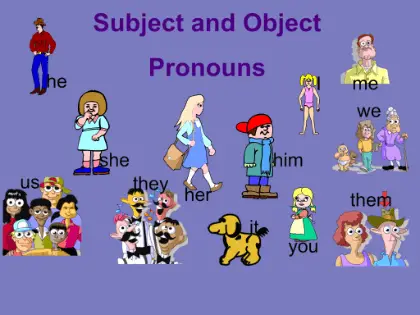We learned the different kinds of pronouns and their functions in school. However, if you have been out of school for several years, you probably have already forgotten the difference between subject and object pronouns. (If you haven’t, kudos to you!) If you are one of those who can no longer tell the difference between the two types of pronouns, you have come to the right place! This article will discuss the uses of and the difference between subject and object pronouns.
Summary Table
| Subject Pronouns | Object Pronouns |
| Replace the subject (nouns) in a sentence; indicate who or what the sentence is about | Replace the object (nouns) in a sentence; directly or indirectly receive the action or preposition in a statement |
| Examples are: “I,” “we,” “you,” “she,” “he,” “it,” and “they” | Examples are: “me,” “us,” “you,” “her,” “him,” “it,” and “them” |
Descriptions

Subject pronouns are words that take the place of the noun subject in a sentence. They do the action in the sentence and they tell us who or what the sentence is about while avoiding redundancy. For example, this sentence does not use subject pronouns:
“Maria is an engineering student. Maria is also a part-time ballet instructor.”
Instead of using the noun “Maria” repeatedly, we can use a pronoun to replace it in the second sentence like so:
“Maria is an engineering student. She is also a part-time ballet instructor.”
In choosing the subject pronoun to use, you have to consider the perspective, number, and gender of the noun it is replacing. Let us take a look at the chart below:
| First Person | Second Person | Third Person | |
| Singular | I | You | She (feminine) / He (masculine) / It (neutral) |
| Plural | We | You | They |
First, you have to consider the perspective. First person pronouns are used when you are talking about yourself (I/we). Second person pronouns are used when you are directly referring to the person you are speaking with (“you” is both singular and plural). Third person pronouns are used when you are talking about other people (not you or your audience).
Next, determine the number of the noun.
The pronouns “she,” “he,” “it,” “you,” and “I” are all singular while the pronouns “we,” “you,” and “they” are all plural.
The pronoun should match the noun it is replacing. That means that if the noun is plural, your pronoun should also be plural.
Finally, consider the gender when applicable. “She” is a feminine pronoun while “he” is a masculine pronoun. The pronoun “it” is usually used for inanimate objects like the weather or food, and animals or babies if the sex is indeterminate. The rest are neutral.
Here are some sample sentences:
- It is freezing outside! (Talks about the weather; third person; neutral; singular)
- We went drinking last night. (The speaker is talking about himself and the other people who did the action; first person; plural)
- Nancy is jealous because she has never been to Disneyland. (Replaces the noun “Nancy”; third person; feminine; singular)
On the other hand, object pronouns are pronouns that replace the object nouns in a sentence. Objects are the words that receive the verb or preposition in the sentence, whether directly or indirectly. This is done in the same way and for the same reasons as subject pronouns.
In choosing an object pronoun, you have to determine the number, gender, and perspective of the noun it is replacing. Take a look at the chart below:
| First Person | Second Person | Third Person | |
| Singular | Me | You | Him (masculine) / Her (feminine) / It (neutral) |
| Plural | Us | You | Them |
Here are some sample sentences:
- Max taught me how to play Roblox. (“Me” receives the action “taught.”)
- Peter showed us around. (“Us” receives the action “showed.”)
- Please share the food with her. (“Her” is the object of the preposition “with.”)
Subject vs Object Pronouns
What, then, is the difference between subject and object pronouns?
Subject pronouns replace the subject (nouns) in a sentence. They indicate who or what the sentence is about. The subject pronouns are “I,” “we,” “you,” “she,” “he,” “it,” and “they.” Conversely, object pronouns replace the object (nouns) in a sentence.
They directly or indirectly receive the action or preposition in a sentence. The pronouns “me,” “us,” “you,” “her,” “him,” “it,” and “them” are object pronouns.





